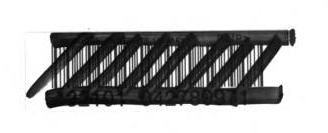I’m excited to share news of a new interdisciplinary project: I’m co-editing the Spring 2015 volume of Media-N, the journal of the New Media Caucus of the College Art Association, on the topic of The Aesthetics of Erasure. The topic for this issue dovetails closely with my current work on my book project Deletions, and I’m looking forward to seeing what I can learn from artists, critics, and other scholars who might be interested in contributing to this conversation.
The official CFP and timeline are pasted below, and you can also view them on the Media-N website or download them here as a PDF. We’d love to receive queries or submissions from anyone interested!
—
Media-N, Journal of the New Media Caucus, is pleased to announce a Call for Proposals for the spring 2015 edition: Vol. 11 – 01
TITLE OF THE EDITION
The Aesthetics of Erasure
GUEST EDITORS
Paul Benzon, Temple University
Sarah Sweeney, Skidmore College
Media-N EDITOR-IN-CHIEF
Pat Badani
………………………………………….
DESCRIPTION
In an era in which state surveillance is capable of capturing, storing, and analyzing all personal communications, and in which even the much-heralded ephemerality of photographic sharing applications such as Snapchat is revealed to be just another instance of deferred, secreted permanence, erasure seems all but impossible. Yet this is precisely what makes erasure a vitally necessary artistic, technological, and social practice. Erasure provides a point of departure from network culture, from the constraints of big data, the archive, and the cloud; through erasure, forgetting and disappearance become radical, profoundly productive acts.
This special issue of Media-N seeks to describe the aesthetics of erasure across various media, platforms, and contexts in the digital era. What does it mean to consider erasure as an artist’s mark, and how does it reshape the relations between making and unmaking? How do acts of erasure allow artists to harness and resist the possibilities and problems of the archive, of (self-) surveillance, of public and private, and of datafication? What are the aesthetic and political relations between erasure and analogous processes such as anonymization and redaction? What antecedents of digital erasure might we see in earlier moments of media history, and how might they help us to see digital erasure in new ways? What do practices of digital erasure, and the absences they produce, tell us about the materiality of digital activity? What relations do they reveal among artistry, audience, memory, temporality, and the market? How might erasure help us to see questions of reproduction, remix, appropriation, and intellectual property in new ways?
The editors invite submissions in all formats and media, and from all disciplines, including but not limited to artwork, artist’s statements, manifestos, interviews, and historical, critical, and theoretical essays.
SUBMISSION GUIDELINES
Please send your proposal adhering to the following:
Written Materials:
– Abstracts should be 300-500 words, submitted as Microsoft Word documents (.doc or .docx).
– Include a proposal title, your email address, and your title/affiliation (the institution/organization you work with if applicable, or independent scholar/practitioner).
– On a separate document, send a Resume or CV (no longer than 3 pages).
Artwork:
– Send 3-5 jpeg images (1200pixels maximum width). Each image should be labeled following the convention Name_Title.jpeg
– On a Microsoft Word document (.doc or .docx) include a project title, your email address, and your title/affiliation (the institution/organization you work with if applicable, or independent scholar/practitioner) and a project description.
– On a separate document, send a Resume or CV (no longer than 3 pages).
SEND THE SUBMISSION TO:
email to: aestheticsoferasure@gmail.com
Subject line: ‘Media-N Submission” and your name(s).
TIMELINE
November 15, 2014: Deadline for submission of abstracts/proposals.
December 15, 2014: Notification of acceptance.
February 15, 2015: Deadline for submission of final papers/artworks.
……………………………………………………………………
If you have questions about Media-N, please feel free to contact:
Pat Badani, Editor-in-Chief Media-N, Journal of the New Media Caucus
Medianjournal.badani@gmail.com
Media-N was established in 2005 to provide a forum for New Media Caucus
members and non-members alike, featuring their scholarly research, artworks and projects. The New Media Caucus is a nonprofit, international membership organization that advances the conceptual and artistic use of digital media. Additionally, theNMC is a College Art Association Affiliate Society.
http://median.newmediacaucus.org/
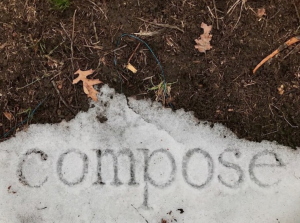 I’m excited to be co-editing with Rita Raley (UCSB) a special issue of ASAP/Journal entitled “New Inscriptions: Writing in the Expanded Field.” We’re looking forward to putting together a rich, interdisciplinary conversation exploring inscription as an aesthetic, material, and social practice.
I’m excited to be co-editing with Rita Raley (UCSB) a special issue of ASAP/Journal entitled “New Inscriptions: Writing in the Expanded Field.” We’re looking forward to putting together a rich, interdisciplinary conversation exploring inscription as an aesthetic, material, and social practice.

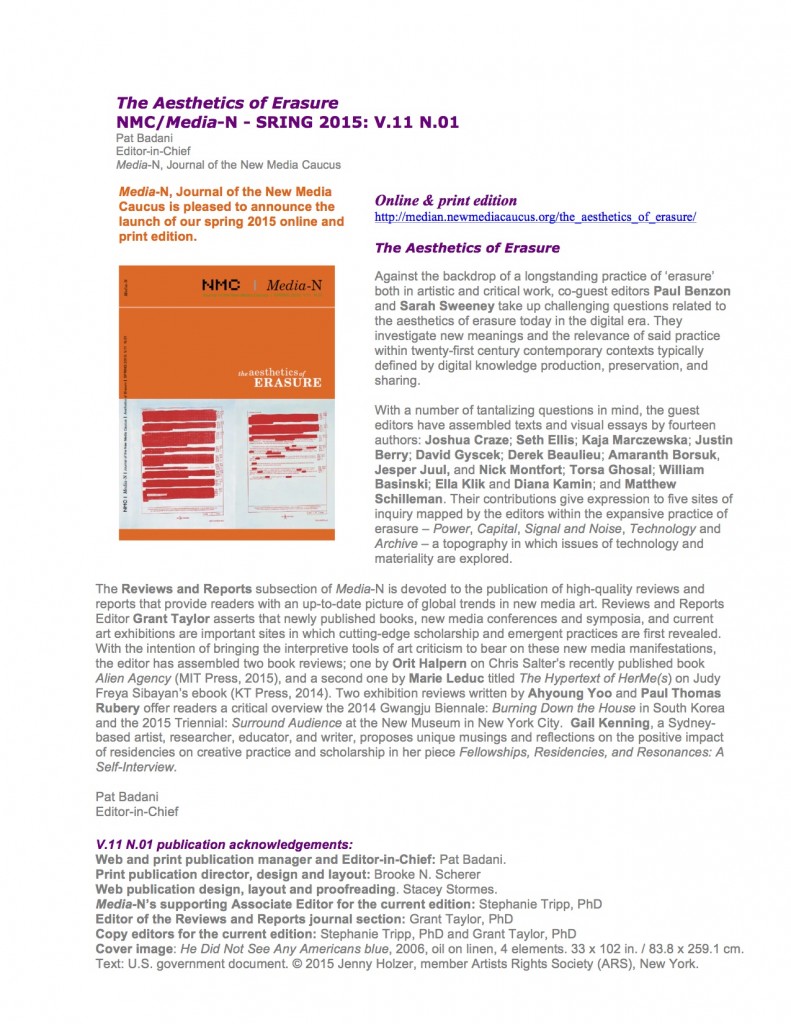
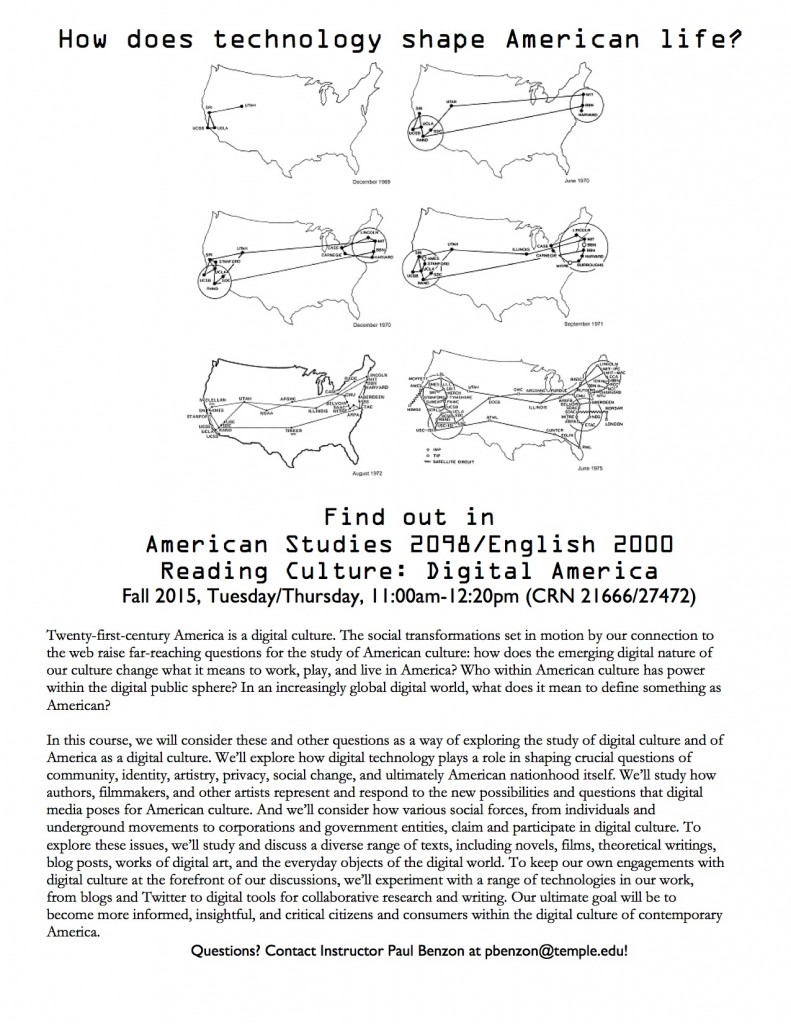

 Ever since Robert Rauschenberg famously erased a Willem de Kooning drawing in 1953, postmodern theorists and writers have been captivated by the practices and provocations of erasure. While the landmark works of visual artists such as Rauschenberg produced a renewed cultural interest in the creative power of “erasure” in their moment, their influence on present-day poets continues to be particularly strong: for several twenty-first century writers, including Jen Bervin and Janet Holmes (one of our panelists), “erasure poetics” has provided an exceptionally potent way of negotiating sites of literary historical memory. Travis Macdonald argues that contemporary erasure poetry, which concerns “itself with the deliberate removal (or covering over) of words on the page” rather than their arrangement on it, protests the seemingly infinite accumulation of digital data in the “Global Information Age.” Yet, according to Macdonald, erasure poetry also forms an inevitable part of our ephemeral modern media landscape of “paste-layered billboards and graffiti-laden walls.”
Ever since Robert Rauschenberg famously erased a Willem de Kooning drawing in 1953, postmodern theorists and writers have been captivated by the practices and provocations of erasure. While the landmark works of visual artists such as Rauschenberg produced a renewed cultural interest in the creative power of “erasure” in their moment, their influence on present-day poets continues to be particularly strong: for several twenty-first century writers, including Jen Bervin and Janet Holmes (one of our panelists), “erasure poetics” has provided an exceptionally potent way of negotiating sites of literary historical memory. Travis Macdonald argues that contemporary erasure poetry, which concerns “itself with the deliberate removal (or covering over) of words on the page” rather than their arrangement on it, protests the seemingly infinite accumulation of digital data in the “Global Information Age.” Yet, according to Macdonald, erasure poetry also forms an inevitable part of our ephemeral modern media landscape of “paste-layered billboards and graffiti-laden walls.”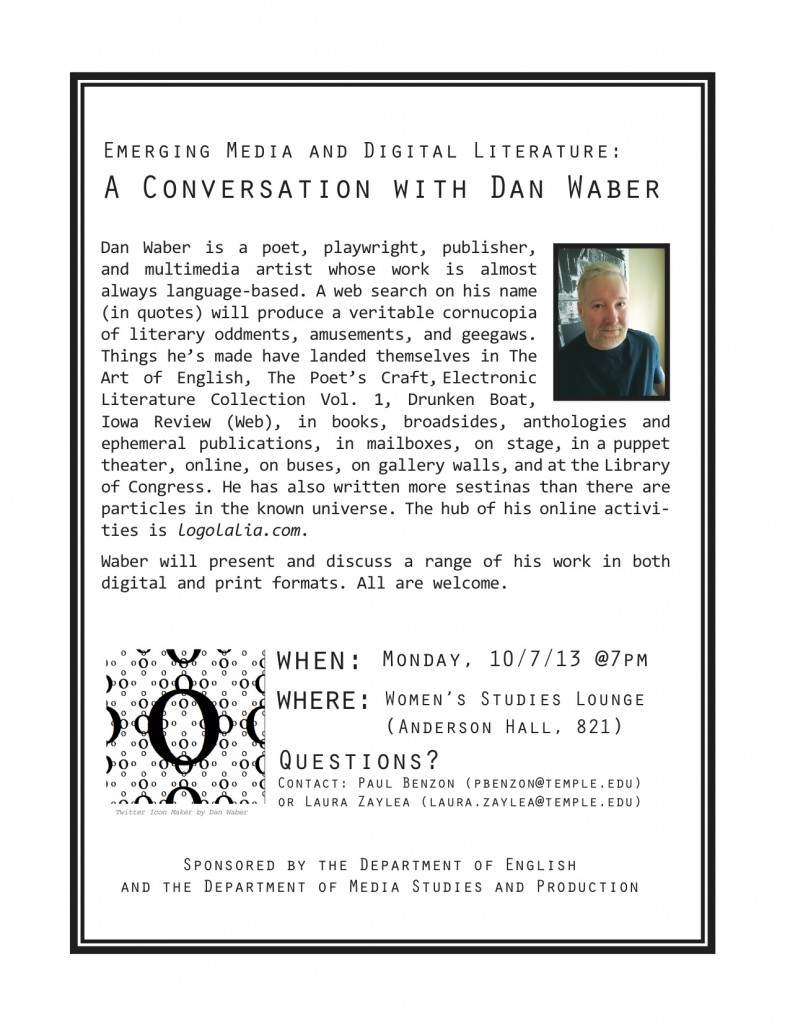
 I’m thrilled to be participating in an exciting project on
I’m thrilled to be participating in an exciting project on